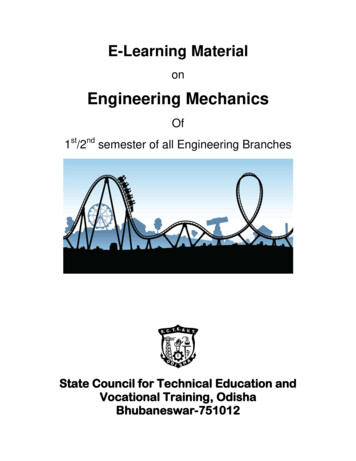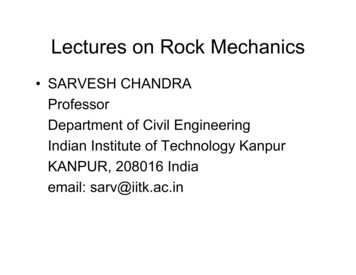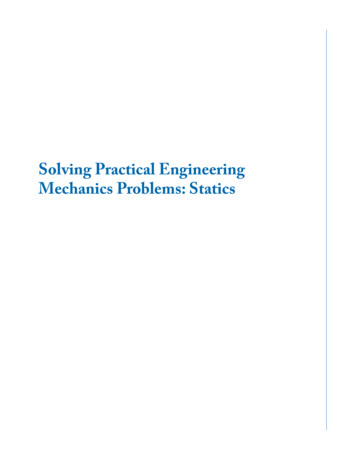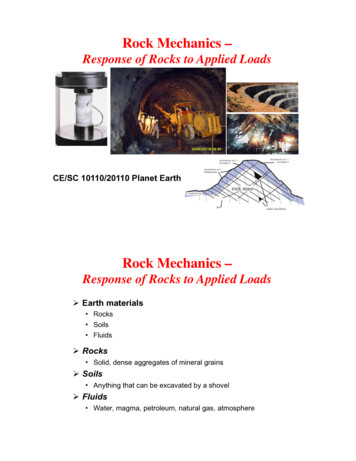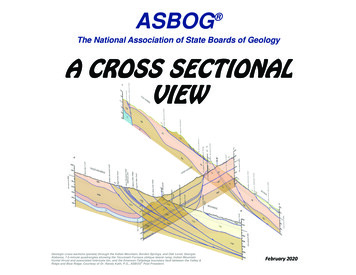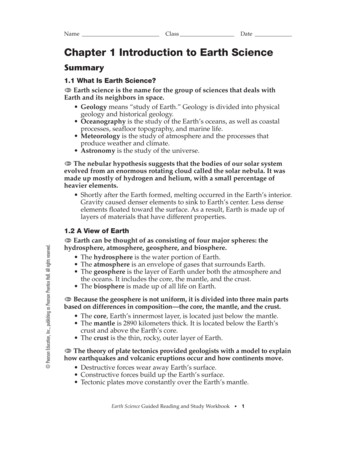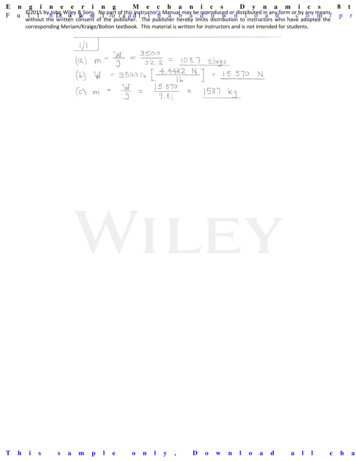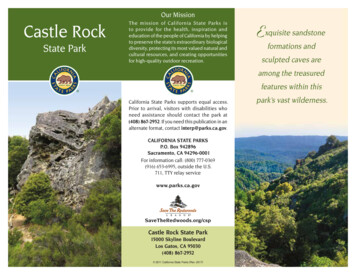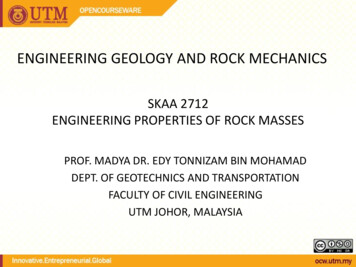
Transcription
ENGINEERING GEOLOGY AND ROCK MECHANICSSKAA 2712ENGINEERING PROPERTIES OF ROCK MASSESPROF. MADYA DR. EDY TONNIZAM BIN MOHAMADDEPT. OF GEOTECHNICS AND TRANSPORTATIONFACULTY OF CIVIL ENGINEERINGUTM JOHOR, MALAYSIA
ENGINEERING PROPERTIES OF ROCKMASSES Rock masses can be considered to be a function of a numberof measurable parameters, with respect to theirgeomechanical properties display in massive and actual form. The properties are determined based on weathering, materialstrength, stratification of lithologies, frequency of jointing,discontinuities, bedding, orientation of joints, infill materialand faults. Whereas material properties refer to the nature of rock in arelatively smaller scale such as mineral composition, grainsize, strength and hardness
Masai, JohorPhoto by Edy Tonnizam 2008
Batu Pahat, JohorPhoto by Edy Tonnizam 2008
Q-system (Barton et al., 1974)ParameterRock Quality Designation (RQD)Joint Set NumberDescriptionRQD is based on the percentage of core pieces thatare 100mm long or more divided with the total lengthof the core.A higher RQD value indicates the rock is betterquality.This is a measure of the number joint sets within therock mass. It has a range between 1 (massive) and 20(crushed).Joint Roughness NumberThis describes the roughness of the joint surface. Itranges from 0.5 for a planar slickensided joint to 4 fora rough and undulating joint.Joint Alteration NumberThis is indicative of the nature of any joint infill. Theextremes are 0.75 for a tight joint with no infill, to 15for a wide joint with substantial clay infill.Joint Water Reduction NumberStress Reduction FactorThis factor account for the strength reducing thenature of water.Stress reduction Factor: This accounts for the stressconditions found in the rock surrounding theexcavation.
RMR (Bieniawski, 1989)Parameter1Strength ofRanges of valuesFor this low range UCS Test ispreferredPLI (MPa) 104 -102-41 -2UCS (MPa) 250100 -25050-10025 - 505 - 251-5 115127421090 -10075 - 9050 -7525 - 50 2520171383 2m0.6 - 2m0.2 - 0.6m0.06 - 0.2mRating2015108Very roughSlightly roughSlightly roughSlickensidedCondition of discontinuitiessurfaces, notsurface,surface,surface or,continuous, noseparation 1separation 1gouge 5mmintactrockRatingRQD2(%)RatingSpacing of discontinuties4separation,mm, slightlymm, highlythick or,unweatheredweathered wallweathered wallseparation 1 -5wall rock 0.06m5Soft gouge 5mm thickor separation 5mm,continuousmm,continuousRating3025None 1020100Inflow per 10mtunnel length25 -125 1250.2 - 0.5 0.510 - 25(Lt/min)5GroundJoint waterwaterpressure/Major0 0.1principal stress0.1- 0.2GeneralconditionsRatingCompletely dryDampWetDripping151074Flowing0
Rock slopes form part of the components in many highwayor roadway constructions in hilly terrain. The key question with regard to rock slopes along highways is their longterm stability since failure of a rock slope can have seriousconsequences. The stability of a particular rock slope isgoverned by three main engineering geologic factors,namely: lithology, structure and weathering grade.
Different lithologies, such as granite versus shale, can havevery different instability problems not only due to theirdifferent material strengths, but also because of thedifferent geologic structures associated with the differentrock types. Hence, for example, the stability of granitic rockslopes is controlled by-and-large by the major sets of jointsin the rock mass, while bedding planes control the stabilityof shale slopes.
Rock Type There are three rock types by origin, which are igneous,sedimentary and metamorphic rock. Igneous rock are formed by cooling of molten magma or lavaoriginated within the earth such as granite and basalt. Thistype of rock is known to be very hard due to the lack ofstratification and weakness planes. Sedimentary rock consists of material derived fromdestruction of previously existing rocks. Their most prominentcharacteristic is bedding or stratification. Once deposited, thesediments are then lithified or turned into rock mass throughprocesses such as compaction and cementation. Compactionis a process where the overlaying of sediment causesdecreases in rock volume and compaction is a chemicalprecipitation process in pores spaces between grains andgluing the rock particles together.
Rock Type On the other hand, metamorphic rock can be ofeither igneous or sedimentary origin, which hasundergone severe changes in pressure, stresses ortemperature. The changes of thisextreme condition may change the original minerals,texture or both, producing different types of rock,namely gneiss (originated from granite), shale, slateand quartzite (from sedimentary origins).
LITHOLOGY Lithology refers to rock type. Lithology is the basic consideration sincedifferent rock types would have different material properties andbehaviour. (Edy Tonnizam et al., 2005) For example, granitic rocks differfrom shales or schists. Limestone is yet another type of rock with its unique solutionproperties. Owing to the different nature and origin of the rock typesmentioned above, the inherent geological structures associated witheach rock type are also different. Thus, granitic rocks are often intersected by three or more sets of majorjoints that would control the stability of the rock slope at a particularlocation (Edy Tonnizam et al., 2013).
On the other hand, shales and sandstones are dominated by beddingplanes, and it is the bedding planes that would control the stability of thecut-slopes. Similarly in phyllites and schists which are foliated, the foliations would bethe controlling features. In the case of limestone cliffs which are characterised by their uniquesolution or karstic features, in particular sub-vertical or overhanging cliffs,the stability of the cliffs is controlled by major joints or faults andsolutioning of the limestone.
WeatheringPhoto by Edy Tonnizam 2008
Strength Compressive and tensile failures of rock areboth involved in the fracture mechanism Smart et al. (1982) have found a closecorrelation between the uniaxial strength andquartz content. They found that the increaseof quartz in rock material would increase thestrength.
Strength In addition to the mineral composition of the rock material,the strength is also considerably influenced by water content.This factor can be a great challenge in weak rocks in tropicalarea where some of the original minerals and fabric haveundergone alteration. Most of the secondary minerals will absorb water easily andwill reduce the original rock strength. Heavy rainfall willincrease the moisture content of the rock material especiallyfor those in highly weathered (Grade IV) and completelyweathered (Grade V) materials. This is due to looseinteraction between grains as weathering has taken place (EdyTonnizam, 2005a).
Point load testerPhoto by Edy Tonnizam 2010
Decreasing in strength due tomoisture contentPhoto by Edy Tonnizam 2008
Old AlluviumPhoto by Edy Tonnizam 2008
Abrasiveness Abrasiveness of rock is a complex function of variousproperties including rock competency, hardness, mineralogicalcomposition and proportions. The grain binding for quartz isan important factor that effects the abrasion of rock material. The parameters affecting abrasiveness are as follows (Singh etal., 1986): 1. Mineral composition and proportions including hardness ofconstituent minerals, grain shape and size, harness andstrength of matrix material. This is determined bypetrographic examinations.2. Physical properties of rocks including strength and hardness.
Several studies were carried out to understand thegeotechnical properties of weathered sedimentary rock inPeninsular Malaysia. The results showed that material properties deteriorate fromthe fresher material as more intense weathering takes place. The weathering effect can take place up to 100m down fromthe earth’s surface in tropical areas (Ibrahim Komoo, 1995).
Rock Structure One of the main factors that affect the behaviour of the rockmass is the structural discontinuities such as joints, beddingplanes, lamination, cleavages and faults. These factors will influence and control the rock massbehaviour. Discontinuity can be defined as a plane of weakness withinthe rock across which the rock material is structurallydiscontinuous and has zero or low tensile strength. In another words, discontinuity is used to describe anymechanical interruption of rock properties.
Orientation The dip and orientation of discontinuities together with jointspacing are critical factors in stability Excavation works may prove easier and more productive ifcarried out parallel to such planes of weakness The joint spacing and orientations will determine thedimensions and shape of rock mass blocks. Orientation of bedded structure can have a particularlyadverse effect causing ripping behaviour similar to a massiverock structure for vertically inclined bedding or for horizontalbedding with wide spacing (Edy Tonnizam et al., 2005b).
OrientationPhoto by Edy Tonnizam 2008
Spacing The presence of joints will reduce the shearstrength of rock mass and their spacinggoverns the degree of such reduction. Even, in most of the rock mass classificationssuch as Rock Mass Rating (RMR) and Q-Systemused in tunnelling, this factor is treated as oneof the main criteria in their assessments.
Closed spacingPhoto by Edy Tonnizam 2007
Gouge The gouge characteristics present in joints alsoplays an outstanding role in stability of rockmass. Where chemical weathering is crucial intropical climate, minerals in rock can bealtered and accumulated at joints opening. Accumulation of iron pan is a good example ofthis secondary product.
Iron panPhoto by Edy Tonnizam 2007
Material Density The degree of cementation, sorting ofsediment, packing of the grain and the shapeof the grains can be assessed by knowing thedensity. Higher density may associates with lesservoids within the rock and strong bondingbetween the mineral grains, hence strongermaterial.
Rock Fabric Fabric is a term used to describe the micro structuraland textural features of rock material. Researchers have found that rock fabric is anotherfactor affecting the strength Coarse-grained rocks (grain size 5mm) such aspegmatite and sandstone can be ripped easily thanfine-grained rocks (grain size 1 mm) such asquartzite, basalt and limestone. It can also be generally assumed that acidic rocks areweaker than basic rocks
The small and larger scale of discontinuity thatare always present in the sedimentary rocksuch as thickness of bedding, joints andfoliation are also need to be assesed. The percentage of dominancy of low or highstrength of rock need to be assessed inadvance as it may cause problems in theassessment.
References Smart, B.G.D., Rowlands, N., and Isaac, A.K. (1982). Progress towards establishingrelationships between the mineralogy and physical properties of coal measures rocks.International Journal of Rock Mechanics. Vol. 19 : 81-89.Barton, N., Lien, R., and Lunde, J. (1974). Engineering classification of rock masses for thedesign of tunnel support. Norwegian Geotechnical Institute Publication : 4-15.Bieniawski, Z.T. (1989). Engineering rock mass classification. New York: John Wiley & Sons.251.Ibrahim Komoo, (1995), Geologi Kejuruteraan- Perspektif Rantau Tropika Lembap: KualaLumpur, Malaysia, Universiti Kebangsaan Malaysia.Edy Tonnizam Mohamad, Khairul Anuar Kassim and Ibrahim Komoo (2005a). Challenges ofRipping Works in Weathered Sedimentary Area. Proceedings 3rd International Conference onGeotechnical Engineering, Semarang, Indonesia : 1-13.Edy Tonnizam Mohamad, Khairul Anuar Kassim and Ibrahim Komoo (2005b). An Overview ofExisting Rock Excavability Assessment Techniques, Jurnal Kejuruteraan Awam, Vol. 17 No. 2 :46-69.Edy Tonnizam Mohamad, Danial Jahed Armaghani, Mohsen Hajihassani, Koohyar Faizi andAminaton Marto (2013), A Simulation Approach to Predict Blasting-Induced Flyrock and Sizeof Thrown Rocks, Electronic Journal of Geotechnical Engineering, V18B, Bund. W (ISSN1089-3032).
Geotechnical Engineering, Semarang, Indonesia : 1-13. Edy Tonnizam Mohamad, Khairul Anuar Kassim and Ibrahim Komoo (2005b). An Overview of Existing Rock Excavability Assessment Techniques, Jurnal Kejuruteraan Awam, Vol. 17 No. 2 : 46-69. Edy Tonnizam Mohamad, Danial Jahed Armaghani, Mohsen Hajihassani, Koohyar Faizi and

